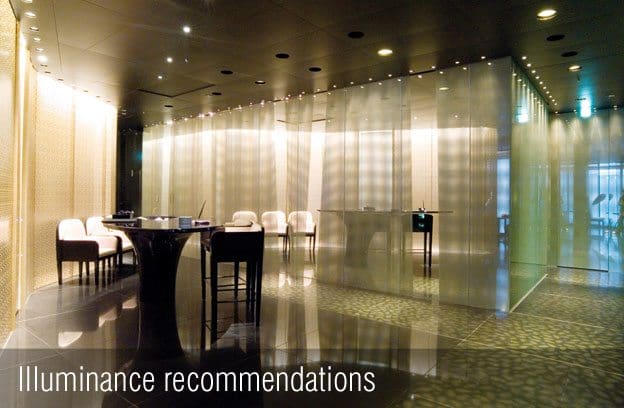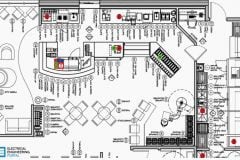Recommended minimum illuminances (E) for typical interior lighting tasks. The illuminances are aimed at a lighting level appropriate to the specific visual tasks to be performed in the space or in a part of the space. They do not include architectural lighting components or other aspects for the specific situation.

The average horizontal illuminances quoted are in accordance with national and international standards. Using the light sources indicated lighting qualities can be achieved to meet the requirements of the particular visual task economically.
| Space/ activity | Recommended min. illuminance E (lx) | Light source |
| Office | 300 | T, TC |
| Team office | 500 | T |
| Open plan office | 750 | T, TC |
| Technical drawing office | 750 | T, TC |
| Data processing | 500 | T, TC |
| CAD | 200/500 | A, QT, T, TC |
| Control room | 200 | TC |
| Corridor | 50 | TC |
| Staircase | 100 | T, TC |
| Canteen | 200 | A, QT, QT-LV, TC |
| Bathroom, WC | 100 | T, TC |
| Sales area | 300 | QT, QT-LV, T, TC, HST, HSE, HIT |
| Department store | 300 | QT, QT-LV, T, TC, HST, HSE, HIT |
| Cashdesk | 500 | T, TC |
| Supermarket | 500 | T, HIT |
| Reception | 200 | A, QT, QT-LV, TC |
| Restaurant | 200 | A, PAR, R, QT, QT-LV, TC |
| Café, bistro | 200 | A, PAR, R, QT, QT-LV, TC |
| Self-service restaurant | 300 | T, TC |
| Canteen kitchen | 500 | T |
| Museum, gallery | 200 | A, PAR, R, QT, QT-LV, T, TC |
| Exhibition space | 300 | PAR, R, QT, QT-LV, T, TC, HST, HSE, HIT |
| Trade fair hall | 300 | T, HME, HIT |
| Library, media library | 300 | T, TC |
| Reading room | 500 | T, TC |
| Gymnasium, competition | 400 | T, HME, HIE, HIT |
| Gymnasium, training | 200 | T, HME, HIE, HIT |
| Laboratory | 500 | T |
| Beauty salon | 750 | QT, QT-LV, T, TC |
| Hairdressing salon | 500 | T, TC |
| Hospital, ward – ambient lighting | 100 | T, TC |
| – reading light | 200 | A, QT-LV, T, TC |
| – examination light | 300 | QT, T, TC |
| Hospital, examination | 500 | T |
| Reception, lobby | 100 | QT, T, TC |
| Circulation area | 200 | QT, T, TC |
| Classroom | 300/500 | T, TC |
| Large classoom | 750 | T, TC |
| College hall | 500 | T, TC |
| Art studio | 500 | T, TC |
| Laboratory | 500 | T, TC |
| Lecture hall, auditorium | 500 | QT, T, TC |
| Multi-purpose space | 300 | QT, T, TC |
| Concert, theatre, festival hall | 300 | A, PAR, R, QT |
| Concert platform | 750 | PAR, R, QT |
| Meeting room | 300 | A, QT, TC |
| Church | 200 | A, PAR, R, QT |
Classification of lamps
The ZVEI, the German Electrical Engineering and Industrial Federation, has developed a system of abbreviations for electric lamps used for general lighting purposes. Some lamp do manufacturers use different abbreviations, however. The ZVEI system of designation consists of up to three characters. These are supplemented by further abbreviations for special models or versions, which are hyphenated.
The first letter indicates the light production.
| I | Incandescent lamp |
| H | High-pressure discharge lamp |
| L | Low-pressure discharge lamp |
The second letter indicates the material of the outer envelope for incandescent lamps, or the gas contained in discharge lamps.
| G | Glass |
| Q | Quartz glass |
| M | Mercury |
| I | Metal halide |
| S | Sodium vapour |
The third letter or combination of letters indicates the form of the outer envelope.
| A | General |
| E | Ellipsoidal |
| PAR | Parabolic reflector |
| R | Reflector |
| T | Tubular |
| TC | Compact tubes |
To complete the classification of a lamp data regarding diameter of lamp or reflector, power, colour of outer envelope, beam spread, type of cap and voltage can be added to the above identification.
The letters in brackets are not used in practice. The resulting abbreviations are given in the right-hand column.
| General service lamp | (I) (G) A | A |
| Parabolic reflector lamp | (I) (G) PAR | PAR |
| Reflector lamp | (I) (G) R | PAR |
| Halogen reflector lamp | (I) Q R | QR |
| Halogen lamp (tubular form) | (I) Q T | QT |
| Mercury lamp (ellipsoidal form) | H M E | HME |
| Mercury lamp (reflector form) | H M R | HMR |
| Metal halide lamp (ellipsoidal form) | H I E | HIE |
| Metal halide lamp (reflector form) | H I R | HIR |
| Metal halide lamp (tubular form) | H I T | HIT |
| High-pressure sodium lamp (ellipsoidal form) | H S E | HSE |
| High-pressure sodium lamp (tubular form) | H S T | HST |
| Fluorescent lamp | (L) (M) T | T |
| Compact fluorescent lamp | (L) (M) TC | TC |
| Low-pressure sodium lamp | L S T | LST |
Abbreviations for special models or versions are separated from the main abbreviation by a hyphen.
| Halogen lamp, double-ended | QT-DE |
| Halogen reflector lamp, coolbeam, without cover | QR-CB |
| Halogen reflector lamp, coolbeam, with cover | QR-CBC |
| Metal halide lamp, double-ended | HIT-DE |
| Compact fluorescent lamp | TC |
| – without starter for EB | TC-EL |
| – with 4 discharge tubes | TC-D |
| – with 4 discharge tubes, with integral EB | TC-DSE |
| – with 4 discharge tubes, without starter for EB | TC-DEL |
| – linear form | TC-L |











hi,,,please help explain Illuminance Recommendation
Thank you it is sufficient for quick decisions.
Madjid.
You’re welcome Madjid! Exactly, this is just a list of recommended illuminance values for various room types. For more accurate results, you’ll need to use some of photometric software.
BR